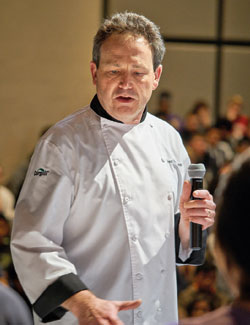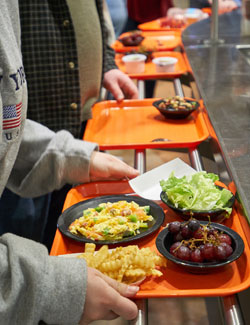Building a better school lunch
Cargill partners with school districts across America to expand menu options and boost nutrition
May 15, 2017
Above: Students at Indian Hills Junior High School in West Des Moines, Iowa, assembled breakfast bowls using Cargill's Sunny Fresh® eggs and a variety of ingredients as their classmates looked on during a friendly competition.
Photos by Mark Luinenburg
Start with scrambled eggs. Add a smorgasbord of potential fixings – diced peppers, onions, ham, crumbled sausage, shredded cheese – and a handful of sauces ranging from barbecue to soy. Spend 10 minutes mixing it all together and you might impress Charlie, an eighth grader at Indian Hills Junior High School in West Des Moines, Iowa.
Charlie has been selected to be the student culinary judge as his peers compete in their own version of the popular Food Network show “Chopped.”
 Cargill Senior Research Chef Brent Preppernau spoke to students about the importance of a nutritious breakfast.
In this version, four teams consisting of three students and a teacher apiece are wearing aprons and chef’s hats. Under the guidance of a Cargill chef, they’re trying to assemble the most enticing new breakfast dish they can dream up as their classmates cheer them on. One group carefully apportions cheese as another sprinkles in jalapenos. With the clock winding down, one competitor throws caution to the wind and pours on sriracha with abandon.
Cargill Senior Research Chef Brent Preppernau spoke to students about the importance of a nutritious breakfast.
In this version, four teams consisting of three students and a teacher apiece are wearing aprons and chef’s hats. Under the guidance of a Cargill chef, they’re trying to assemble the most enticing new breakfast dish they can dream up as their classmates cheer them on. One group carefully apportions cheese as another sprinkles in jalapenos. With the clock winding down, one competitor throws caution to the wind and pours on sriracha with abandon.
They get a final 10-second countdown from the crowd, and then it’s time to present their creations. It’s up to Charlie and the rest of the panel – a few more teachers, the principal and the district’s nutrition experts – to pick a winner. They huddle for a few minutes before Charlie takes the microphone to render the verdict.
One offering, he explains, was nice but “a little plain.” Another “might be a little too hot for people who don’t like spicy.” A third has an intriguing presentation, he says but the prize ultimately goes to the “Rainbow Western Hash” – fluffy Sunny Fresh® eggs, salsa and fresh veggies topped with queso sauce.
“I think everyone will like this one,” Charlie says.
A complex equation
The students might not have known it, but the competition – a prize won by the school district for stopping by Cargill’s booth at the School Nutrition Association’s annual national conference in Texas in 2016 – offered a window into the challenges and complexities of putting together a school meal.
It has to be healthy enough to meet government standards – for instance, it can’t have too much sodium and at least 51 percent of the flour in any bread products must be whole-grain. It has to be easy to prepare in bulk with limited time and labor – a challenge considering a high school cafeteria might serve a thousand students in an hour.
The ingredients need to be flexible enough to work in more than one dish on the menu. And above all, it has to taste good.
“If kids don’t want to eat it, then the product’s not going to go very far,” said Brent Preppernau,
 Students made their choices in the lunch line. For schools, government funding for meals largely depends on student participation, so they're always looking for new ways to keep kids interested in the menu.
Cargill senior research chef in the protein business.
Students made their choices in the lunch line. For schools, government funding for meals largely depends on student participation, so they're always looking for new ways to keep kids interested in the menu.
Cargill senior research chef in the protein business.
He’s responsible for helping schools and other customers develop new products that check all those boxes – and he’s the one who made the trip from Minneapolis to West Des Moines as the company’s “celebrity chef.”
A successful school menu item “has to appeal to a pretty broad base,” Preppernau said. And meal programs can’t afford to get stale. “Kids today like things that are different than kids liked 20 years ago,” he said. “You want to add things that are new.”
Evolving along with tastes are the things parents and school administrators value. Tracking with broader consumer trends, things like simple labels, traceable supply chains and fewer antibiotics are all increasingly important in school meals.
“Consumers really want to understand where their food comes from and what they’re eating,” said Suzanne McCarty, director of business development for government and K-12 customers in Cargill Foodservice.
Parents are no different, and in recent years have leaned on school foodservice directors to live up to those standards. Schools, in turn, turned to Cargill, which supplies more than 2,500 districts in 35 states as part of the National School Lunch Program serving a variety of products made from eggs and turkey.
“We’re listening to our customers – parents and students – and looking at how their needs change,” McCarty said.
The company’s Shady Brook Farms® brand of turkey products, for example, provides school districts with a range of products from sliced deli meat to turkey hot dogs. All Shady Brook Farms brand turkeys are raised by independent family farmers who use antibiotics only to treat illness, not promote growth. In an industry first, Cargill worked with the United States Department of Agriculture to ensure turkey production practices for the Shady Brook Farms brand achieve the Certified Responsible Antibiotic Use designation from the School Food Focus group.
“They really are looking for a product that’s healthy, but also tastes good and is affordable,” said Kassie Curran, associate brand manager with Cargill Protein.
Cargill’s Sunny Fresh eggs, meanwhile – the brand behind the Indian Hills event – recently launched an egg patty with just four ingredients. It’s also working with food manufacturers to remove high-fructose corn syrup from French toast products, which makes them more attractive to some school districts.
“We know that schools are really focused on a clean label,” said Kelsey Morgan, assistant marketing manager for Cargill Protein. “We want to help them make parents feel more comfortable.”
Keeping kids interested
A modern high school cafeteria is a sea of choices. At Valley High School, a little more than a mile up the road from Indian Hills, offerings ranging from teriyaki chicken to beef enchiladas to stuffed crust pizza to salad bar vie for students’ attention.
Keeping them interested is critical. For schools, students are the customers – and meal funding depends on their participation.
Willow Dye, director of nutrition services for West Des Moines Community Schools, pays close attention to what’s popular. If dishes are a consistent hit – orange chicken, for instance – “it pays to cycle through them on the menu.”
She and her staff will go into classrooms on occasion to let students plan menus and build dishes. That typically produces colorful combinations – recently, it was hamburgers, mashed potatoes and watermelon – or requires a shipment of exotic ingredients like passionfruit.
Like everyone else, Dye said, “they like being able to make choices in what they’re having.”
Today, there’s a new choice in the Valley High cafeteria: an omelet bar.
It’s part of the same Sunny Fresh program as the Indian Hills competition, coinciding with National School Breakfast Week. Chef Preppernau is manning the griddle while McCarty, Dye and Brianna Shanks – the purchasing and production coordination for West Des Moines School Nutrition – prepare made-to-order recipes with ingredients like spinach, onions, peppers and sausage.
“Omelet for lunch?” Preppernau offers to a teenage boy in headphones. He doesn’t bite, but a few girls wander up, inquisitive. “I’d like to try it,” one says.
They’re trendsetters: In a few minutes, it’s the longest line in the room. Over the course of an hour, hundreds of students come through. As they wait, they chat about what pulled them in. One girl liked the healthy options. A boy who was fresh off wrestling practice liked the choice of ingredients. His pick? “I’ll take all of it.”
More than a few were excited to have breakfast for lunch. That’s no surprise to Preppernau, who said that’s “always one of the most popular days on the school menu.”
And building an omelet fits into the broader trend of customizing your own dish. “We’re helping schools figure out how to achieve that,” he said.
Some students ask if the station will be back tomorrow. For now, it’s a one-day engagement – and a learning experience for students and Cargill alike.
“It’s great for us to see what resonates with the kids,” McCarty said. “We’re working with schools to really be a partner, and trying to help them think outside of the box.”
